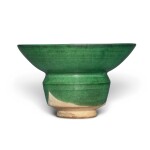Celestial Colors. The Cadle Family Collection of Chinese Monochromes
Celestial Colors. The Cadle Family Collection of Chinese Monochromes

An extremely rare green-glazed zhadou, Liao dynasty | 遼 綠釉渣斗
Auction Closed
March 21, 02:11 PM GMT
Estimate
8,000 - 12,000 USD
Lot Details
Description
An extremely rare green-glazed zhadou
Liao dynasty
遼 綠釉渣斗
Diameter 7 ⅛ in., 18 cm
Collection of Ip Che.
Sotheby's New York, 3rd June 1987, lot 166.
J.J. Lally & Co., New York.
葉智收藏
紐約蘇富比1987年6月3日,編號166
藍理捷,紐約
The distinctive form of the present vessel, with its globular body and flaring dished mouth, is usually referred to as a leys jar, or zhadou. The function of such vessels is still open to debate but was probably used as a waste receptacle for wine dregs or tea leaves. They were popular in Northern China during the Tang and Liao dynasties where they were produced by various kilns. The ceramic models were likely inspired by metalwork prototypes, such as two Tang silver zhadou illustrated in Tangdai Jinyin Qi [Gold and silver wares from the Tang dynasty], Beijing, 1985, pls 255 and 278. The present zhadou follows the tradition of earlier Tang dynasty ceramics. The Liao dynasty was founded in 907 AD by the Qidan, a semi-nomadic people from Manchuria. Whilst the Qidan had no glazed pottery tradition of their own, they quickly adopted the sponsorship of kilns in their occupied territories of present-day Hebei province, and parts of Manchuria and Inner Mongolia and employed Chinese potters. Liao ceramics continued many Tang ceramic traditions, including the application of a slip, whilst leaving a band of natural clay exposed. The rich emerald-green glaze is one of the three lead glazes used for the sancai wares of the Tang.
Liao green-glazed zhadou are exceptionally rare. Compare examples from other kilns, including an earlier white-glazed Tang dynasty example from the Carl Kempe Collection, extensively exhibited, including in the Oriental Ceramic Society exhibitions The Arts of the T'ang Dynasty, London, 1955, cat. no. 212 and Collectors, Curators, Connoisseurs: A Century of the Oriental Ceramic Society 1921-2021, London, 2021, cat. no. 51. See also a white-glazed Ding zhadou, excavated in Inner Mongolia, illustrated in The Complete Collection of Ceramic Art Unearthed in China, vol. 4, Beijing, 2008, pl. 52.
